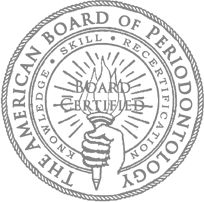Periodontist
Treatment of Periodontal Disease
Non-Surgical Periodontal Therapy
Periodontal disease, or Periodontitis is an infection caused by bacteria which are present in the oral cavity, and which adhere to the teeth. Over time, if not removed, this bacterial plaque tends to harden or calcify and become tarter, or calculus. The presence of bacterial plaque and calculus, if unchecked, will cause redness and swelling of the gum tissue surrounding the teeth. This is called gingivitis, and gingivitis is easily reversed, by professional debridement and good home care by the patient.
If plaque and calculus remain on the tooth surface, and inflammation is not addressed, loss of the bone which supports the teeth will occur. This is evident on radiographs, and by increased probing depths, bleeding upon probing and often purulence or pus emanating from the tissues surrounding the teeth. Periodontitis is generally not painful, and often the first manifestation is inflammation, and if allowed to progress untreated, it can lead to mobility of the teeth, and in advanced cases, loss of teeth.
The first step of periodontal treatment is debridement of plaque and calculus. This is accomplished by a thorough professional cleaning of the teeth, either by a registered dental hygienist, a dentist, or a periodontist. This procedure is called scaling and root planing, and is often performed with local anesthesia. Generally treatment is rendered on one side of the mouth and the second side is treated later.
Depending upon the severity of the periodontal disease, scaling and root planing may result in complete resolution, or further, surgical periodontal therapy may be necessary to establish a state of periodontal health. One of the most important aspects of periodontal therapy is the establishment of a meticulous home care regimen by the patient. Studies have shown that periodontal therapy in the absence of good home care will almost always, fail.
Appropriate home care means brushing, flossing and rinsing with an antibacterial mouthwash twice a day. Doctor Bouffard and his staff will recommend an appropriate home care regimen, including specific toothbrush, floss and mouthwash recommendations following your initial consultation, based upon many factors. You may be prescribed medication or prescription mouthwashes or other medications to further assist you in your quest to achieve periodontal health. A list of these medications and links for further information is included in the links section of this webpage.
Surgical Periodontal Therapy
When gingivitis is allowed to progress, periodontal pocket depth increases, plaque and calculus continue to build up on root surfaces, and the underlying bone become damaged. This is called periodontitis, and it is a generally progressive, non-tender condition which is the most common cause of premature tooth loss in humans worldwide. Success of non-surgical periodontal treatment is dependent almost exclusively upon one factor. Accessibility to thoroughly debride (clean) the root surfaces, by the patient and the dental professional. If the root surfaces are not able to be thoroughly cleaned by scaling and root planing, it may become necessary to perform periodontal surgical therapy.
Debridement of contaminated root surfaces and regeneration of damaged supporting bone are the two goals of surgical periodontal therapy. These are generally accomplished simultaneously. Access to the root surfaces is accomplished by making the tissue numb, making an incision between the teeth, and gently reflecting a flap of soft tissue, exposing the underlying bone and tooth surfaces. A variety of instruments are used to debride the root surfaces and remove infected soft tissue from the bone defects. The roots are cleaned, and treated with an antibiotic solution to decontaminate them of any residual bacterial contaminants.
Osseous (bone) defects are generally grafted following debridement of the root surfaces. Bone graft materials can be synthetic, donor material from other humans or animals, or the patient’s own bone, harvested from adjacent sites. Synthetic materials generally are the least effective. Bone from other species has long been used, but due to concerns about disease transmission, they are not used in this practice. Human bone graft material, either from the surgical site, or nearby tissue, or donated human bone is generally most effective. Human bone graft material in our practice is sourced from only one tissue bank, Lifenet. I trust that their screening and processing results in a safe and biologically active material.
Osseous Periodontal Surgery is a very safe and effective method to control periodontal disease and restore lost tissue. Other types of surgical periodontal therapy may be appropriate in individual circumstances. Different periodontists may recommend different treatment modalities. Our practice philosophy is a regenerative philosophy. In most cases, it is best to attempt to arrest the progression of periodontal disease and regenerate lost tissue to the greatest extent possible.




